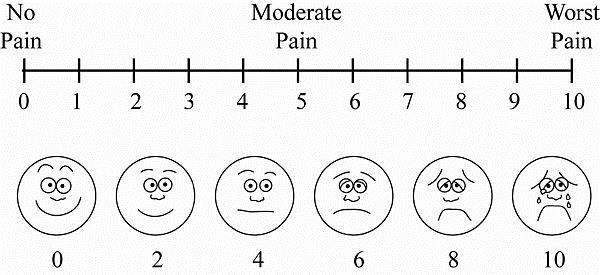With pain management, one size does not fit all. Everyone tolerates pain differently. What may be extremely painful to you, may not be painful to your rehab buddy. For this reason, we want to give you individualized and appropriate pain management care. You will have pain from your joint replacement surgery, however, our goal is to decrease your pain to a tolerable level so you can complete therapy and live your life.
We will ask you to rate your pain on a 0-10 scale. A 0 means no pain at all versus a 10, meaning the worst pain imaginable. Our goal, once again, is to keep your pain at a tolerable level. For many people this means at a 4 or below. Start thinking about your scale. See the image below for help.
Open communication is the key between you and your nurses. When your pain level starts to increase, it is important to tell your nurses right away so they can “keep up with“ the pain before it increases to a higher level. We believe a team effort is essential for good pain relief, and you are the key player.

Pain management options
- Intravenous (IV) pain medications may be used for breakthrough and quicker pain relief immediately after the surgery, depending on what your surgeon orders.
- Oral pain medications are started after your surgery for longer lasting pain relief. We offer a variety of pain medications, so it is important for you to communicate with your nurse if your pain is not at a tolerable level. Once again, the type of pain medications ordered will depend on your Surgeon. You will most likely be discharged home with the same pain medications.
- Ice is an effective way to help control your discomfort. You may have an icing device or an ice bag applied to your surgical incision site. Ice helps decrease inflammation, which helps decrease pain.
- Relaxation techniques are very useful to control pain levels. We encourage deep breathing, imagining your favorite place to vacation, working on a hobby, or listening to music. Visualize yourself in the hospital, getting out of bed, walking into the bathroom, and completing your exercises successfully.
